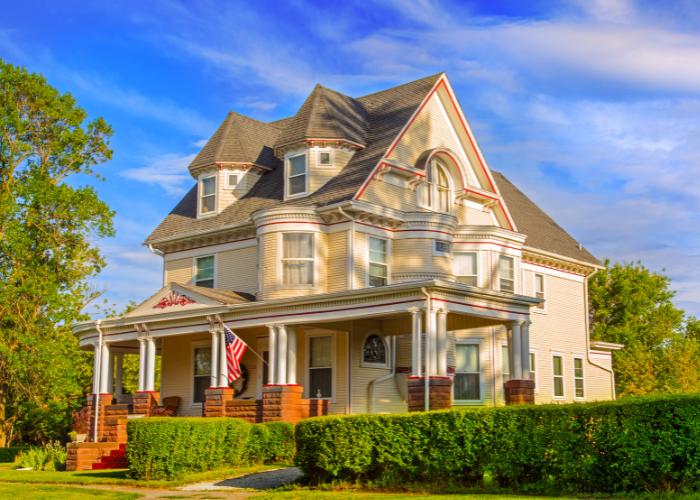Denver is a walkable city with breathtaking natural views and nearly 300 days of sunshine annually. It’s attractive, with a diverse range of architectural styles to match your preferred aesthetics, but that’s not the only reason people invest in Denver’s real estate!
The city has a dynamic and diverse economy and a GDP growth rate that’s more than twice the nation’s total, essentially making real estate in the area recession-proof.
Plus, it attracts a decent number of tourists (20.5 million overnight visitors in 2023!), which has the potential to give you good rental yields. You can tap into photorealistic renderings to elevate the architecture of Denver houses and increase your bookings.
Popular Styles Around Denver
Here’s a look at the most remarkable architecture of Denver houses:
1. Craftsman
Craftsman style is a harmonious blend of design and aesthetics. It can be made in various sizes and shapes. It is characterized by handcrafted details, natural materials, earthy tones, and large front porches. However, they can appear dark and gloomy with their overhanging roofs.
Its attention to detail comes at a premium. It can cost roughly 20% to 30% more than a mass-produced property in another style.
You can find charming Craftsman structures in City Park, Congress Park, Pinehurst Estates, Platt Park, West Highlands, and Washington Park.
2. Denver Square
Denver Square is the regional term for American Foursquare.
True to its name, this elegant design puts efficiency and practicality front and center. It possesses a boxy shape with two- or two-and-a-half stories that are usually divided into four parts by a central staircase. It has a simple floor plan, so it’s easy to upgrade and remodel.
You can find these houses in the Country Club, Highland, and Congress Park.
3. Mid-Century Modern
Denver’s mid-century modern architecture is a delightful blend of the past and contemporary lifestyles. It is bold and distinguishable by its angular roof lines, spacious courtyards, tongue and groove ceilings, enormous picturesque windows, and wide open spaces.
Plus, there’s a wide variety of sub-architectural styles to choose from, ranging from Art Deco and Brutalist to Expressionism and Streamline Moderne.
Walk through the Virginia Village, University Hills, and the Krisana and Harvey Park neighborhoods to appreciate this style.
4. Ranch
Easy-going family-friendly ranch-style homes dominated the postwar boom. They’re unpretentious, with slightly slanted roofs, large windows, an asymmetrical facade, and an open floor plan. They often have a garage attached and easy access to the rear porch or patio.
While they’re typically built as single stories, you can also incorporate a basement for extra living space and to accommodate your growing family.
Ranch-style architecture can be seen in various neighborhoods in Denver, including Aspen, Athmar Park, Barnum, Central Park, Lowry, Park Hill, Regis, Skyland Park, Washington Park, Wellshire, and Valverde.
5. Tri-Level
A tri-level home, also referred to as a split-level home, is a combination of a two-story home and a ranch. It has multiple levels connected by two sets of short stairs. Levels are often staggered, with the main level (the one with the front entrance) containing living areas that lead to the outdoors.
Find tri-level homes in Goldsmith, Hampden, Montbello, and Southmoor Park.
6. Tudor
Tudor-style homes are designed to withstand heavy rain and snowfall, perfect for the Denver climate. They have overlapping, pitched gable roofs, decorative timbering that elevates stucco, brick, or stone facades, wall paneling, and tall, narrow multi-pane windows.
It’s a unique style that’s become quite rare.
If you want to get a taste of its whimsical feel, head to the neighborhoods of Belcaro, Bonnie Brae, Hale, Montclair, Park Hill, Berkeley, and Sloan’s Lake.
7. Victorian
Denver’s Victorian architecture uses bricks, not decorative wood frames. This trend began after a disastrous Denver fire destroyed over 70 buildings in 1863, leading to the enforcement of “The Brick Ordinance”.
Other characteristics remain faithful to the classic style: two to three levels, grand entrances, elaborate outdoor spaces, and sweeping staircases. You can choose from the popular Gothic revival and Romanesque revival sub-styles.
The stunning 1892 Queen Anne Victorian is a fine example of a Victorian structure.
To make these distinctive architectural styles your own, Plus Render can create 3D digital renders based on your preferences and your parcel of land in Denver. We can even help you with interior, exterior, and aerial views of your future home.
Navigating Denver’s Real Estate Landscape
Investing in a Mile High City home?
While the capital of Colorado has experienced some of the highest appreciation rates—a grand total of 105.82% over the last decade—rising interest rates and record-low inventories can make it difficult to acquire property.
But you can still make a sound investment by heeding our advice:
Focus on Location
Denver has 78 neighborhoods, each with different amenities and facilities. Here’s what to consider when surveying different areas:
- Recreational facilities in the area
- Connectivity, access to public transport
- Availability of schools, colleges, and other educational institutions
- Safety, choose neighborhoods with low crime rates and adequate police presence
Most importantly, consider its resale value and the rental market if you’re investing. Chaffee Park, Hampden South, Lower Downtown (“LoDo”), RiNo (River North Art District), West Barnum, and West Colfax are some of the best locations with good returns.
Think About the Price
Demand outpaces supply in Denver, resulting in a strong seller’s market.
Buyers must be prepared to pay top dollar, sometimes over the asking price. The median sale price was $590K in July 2024, which can be discouraging. But you can still consider Denver’s suburbs if you want more reasonable prices.
Here’s a look into the top areas and their median home values: Westminster ($64K), Broomfield ($77K), Centennial ($89K), and Erie ($103K).
Don’t Overlook New Property Developments
Investing in planned real estate developments is a great way to buy a home in your preferred area. You’ll pay less, get good discounts and price reductions for add-ons, and can choose a floor plan that meets your needs.
Since the property is built with new technology and high-performing materials, you’ll also pay lower maintenance fees in the initial years. When you decide to sell, it will fetch competitive market rates.
Secure Financing
There are many financial assistance programs for first-time buyers and seasoned investors who don’t want to put all their cash into one project.
Consider a mortgage for example. To obtain a conventional loan, you’ll need a credit score of 620 and up, a debt-to-income ratio below 43%, and a downpayment equivalent to at least 3% of the property’s purchase price.
Requirements will change depending on your loan provider. The Federal Housing Administration has a $684,250 limit and requires mortgage insurance during the loan’s lifespan.
Work With a Real Estate Agent
Sure, you can browse Zillow, Redfin, and Realtor, but they won’t give you enough information to make an informed buying decision.
Real estate agents know the market and have extensive knowledge of its past, present, and future trends. They can help you zero in on homes, condos, and bungalows in a neighborhood that matches your lifestyle and budget. They may even be able to share virtual tours which helps set expectations, especially if you aren’t from a nearby area.
Of course, their guidance isn’t free. They typically charge a 5.10% commission.
Make Informed Real Estate Decisions With Plus Render
Buying a home in Denver is exciting but comes with its share of risks. If you’re building a new structure or renovating, 3D architectural firm Plus Render can help you avoid unpleasant surprises, prevent unnecessary expenses, and make the process smoother.
We can recreate the architecture of Denver houses based on your preferences and chosen style. Plus Render eliminates uncertainty with high-quality detailed visuals. Check out our portfolio to see what we can do.







